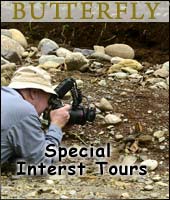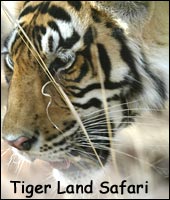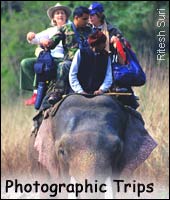HOME : Birding in India : Ramsar Sites
in India
RAMSAR SITES IN INDIA
Ramsar SitesThe Convention on Wetlands of International Importance adopted at Ramsar, Iran in Feb. 1971, popularly known as Ramsar Convention, aims to preserve and protect wetland ecosystems together with dependent water bird species and make the wise use of wetlands for the benefit of people.
Wetlands cover 3 % of the Indian landmass and harbor a vast variety of life forms that are a part of the complex food of these transitional ecosystems. About 320 species of birds are associated with the Indian Wetlands. Apart from birds, the wetlands support a diverse population of plants & animals including 150 species of amphibians.
Since signing this convention in 1982, India has till date designated 37 wetlands as Ramsar sites.
Some of these sites are:
Bhoj Wetland
Included on 19/08/02. in Madhya Pradesh. is two contiguous human-made reservoirs - the "Upper Lake" was created in the 11th century by construction of an earthen dam across the Kolans River, and the lower was constructed nearly 200 years ago, largely from leakage from the Upper, and is surrounded by the city of Bhopal. The lakes are very rich in biodiversity, particularly for macrophytes, phytoplankton, zooplankton, both natural and cultured fish species, both resident and migratory birds, insects, and reptiles and amphibians. A number of bird species have been sighted which had rarely or never before been seen in the region since last couple of years.
Kanjli Lake
Included on 22/01/02 in Punjab is a permanent stream, the Kali Bein, converted by construction of a small barrage in 1870 into a water storage area for irrigation purposes. The site fulfils Criteria 3 because of its importance in supporting a considerable diversity of aquatic, mesophytic, and terrestrial flora and fauna in the biogeographical region, and acts also as a key regulator of groundwater discharge and recharge with the seasons. By this means and by direct abstraction of water for irrigation by the local population, the site plays a crucial role in the agriculture which predominates on the surrounding fertile plain, with fewer pressures upon water supplies than elsewhere in the Punjab.
Harike Wetland
Included on 23/03/90 in Punjab is a shallow water reservoir with thirteen islands, at the confluence of two rivers. Dense floating vegetation covers 70% of the lake. An important site for breeding, wintering and staging birds, supporting over 200,000 Anatidae (ducks, geese, swans, etc.) during migration.
Ashtamudi Lake
Included on 19/08/02 is an extensive estuarine system, the second largest in Kerala State, which is of extraordinary importance for its hydrological functions, its biodiversity, and its support for fish. The site supports a number of mangrove species as well as over 40 associated plant species, and 57 species of birds have been observed, including six that are migratory. Nearly 100 species of fish are to be found in this area.
Deeper Beel
Included on 19/08/02 in Assam.is a permanent freshwater lake in a former channel of the Brahmaputra river, of great biological importance and also essential as the only major storm water storage basin for the city of Guwahati. The beel is a staging site on migratory flyways and some of the largest concentrations of aquatic birds in Assam can be seen, especially in winter. Some globally threatened birds are supported, including Spotbilled Pelican (Pelicanus philippensis), Lesser and Greater Adjutant Stork (Leptoptilos javanicus and dubius), and Baer's Pochard (Aythya baeri).
Chilka Lake
Included on 01/10/81 in Orissa is a brackish lake separated from the Bay of Bengal by a long sandy ridge and subject to sea water exchange, resulting in extreme seasonal fluctuations in salinity in different sections of the lake. Saline areas support aquatic algae. The site is an important area for breeding, wintering and staging for 33 species of waterbirds. It also supports 118 species of fish, including commercially important species.
Kolleru Lake
Included on 19/08/02 in Andhra Pradesh is a natural eutrophic lake, situated between the two major river basins of the Godavari and the Krishna, fed by two seasonal rivers and a number of drains and channels, which functions as a natural flood balancing reservoir between the deltas of the two rivers. It provides habitat for a number of resident and migratory birds, including declining numbers of the vulnerable Grey Pelican (Pelecanus philippensis), and sustains both culture and capture fisheries, agriculture and related occupations of the people in the area.
Keoladeo National Park
Included on 01/10/81 in Rajasthan is a World Heritage Site and has a complex of ten artificial, seasonal lagoons, varying in size, situated in a densely populated region. Vegetation is a mosaic of scrub and open grassland that provides habitat for breeding, wintering and staging migratory birds. Also supported are five species of ungulates, four species of cats, and two species of primates, as well as diverse plants, fish and reptiles. The canal provides water for agriculture and domestic consumption. Cattle and water buffalo graze on the site.
Bhitarkanika Mangroves
Included on 19/08/02. in Orissa. is one of the finest remaining patches of mangrove forests along the Indian coast - 25 years of continued conservation measures have made the site one of the best known wildlife sanctuaries. The site's Gahirmatha beach is said to host the largest known Olive Ridley sea turtle nesting beach in the world, with half a million nesting annually, and the site has the highest density of saltwater crocodile in the country, with nearly 700 Crocodylus porosus. It is a major breeding and wintering place for many resident and migratory waterbirds and is the east coast's major nursery for brackish water and estuarine fish fauna. Like many mangrove areas, the dense coastal forests provide vital protection for millions of people from devastating cyclones and tidal surges - of India's 58 recorded species of mangroves, 55 species are found in Bhitarkanika, a wider mangrove diversity than in the Sundarbans!
East Calcutta Wetlands
Included on 19/08/02 in West Bengal. is world-renowned as a model of a multiple use wetland, the site's resource recovery systems, developed by local people through the ages, have saved the city of Calcutta from the costs of constructing and maintaining waste water treatment plants. The wetland forms an urban facility for treating the city's waste water and utilizing the treated water for pisciculture and agriculture, through the recovery of nutrients in an efficient manner - the water flows through fish ponds covering about 4,000 ha, and the ponds act as solar reactors and complete most of their bio-chemical reactions with the help of solar energy. Thus the system is described as "one of the rare examples of environmental protection and development management where a complex ecological process has been adopted by the local farmers for mastering the resource recovery activities" (RIS). The wetland provides about 150 tons of fresh vegetables daily, as well as some 10,500 tons of table fish per year, the latter providing livelihoods for about 50,000 people directly and as many again indirectly.
Point Calimere
Included on 19/08/02.in Tamil Nadu. is situated in coastal area consisting of shallow waters, shores, and long sand bars, intertidal flats and intertidal forests, chiefly mangrove, and seasonal, often-saline lagoons, as well as human-made salt exploitation sites. Some 257 species of birds have been recorded, 119 of them waterbirds, including the vulnerable species Spoonbill Sandpiper (Euryhorhynchus pygmaeus) and Grey Pelican (Pelecanus philippensis) and some 30,000 Greater and Lesser Flamingos. The site serves as the breeding ground or nursery for many commercially important species of fish, as well as for prawns and crabs.
Vembanand-Kole Wetland
Included on 19/08/02 in Kerala. is the largest brackish, humid tropical wetland ecosystem on the southwest coast of India, fed by 10 rivers and typical of large estuarine systems on the western coast, renowned for its clams and supporting the third largest waterfowl population in India during the winter months. Over 90 species of resident birds and 50 species of migratory birds are found in the Kol area.
Ropar Lake
Included on 22/01/02 in Punjab is a human made wetland of lake and river formed by the 1952 construction of a barrage for diversion of water from the Sutlej River for drinking and irrigation supplies. The site is an important breeding place for the nationally protected Smooth Indian Otter, Hog Deer,Sambhar , and several reptiles, and the endangered Indian Pangolin (Manis crassicaudata) is thought to be present. Some 35 species of fish play an important role in the food chain, and about 150 species of local and migratory birds are supported.
Tsomiriri
Included on 19/08/02 in Jammu & Kashmir is a freshwater to brackish lake lying at 4,595m above sea level, with wet meadows and borax-laden wetlands along the shores. The site is said to represent the only breeding ground outside of China for one of the most endangered cranes, the Black-necked crane (Grus nigricollis), and the only breeding ground for Bar-headed geese in India. The Great Tibetan Sheep or Argali (Ovis ammon hodgsoni) and Tibetan Wild Ass (Equus kiang) are endemic to the Tibetan plateau, of which the Changthang is the westernmost part.
Wular Lake
Included on 23/03/90 in Jammu & Kashmir is the largest freshwater lake in India with extensive marshes of emergent and floating vegetation, particularly water chestnut, that provide an important source of revenue for the State Government and fodder for domestic livestock. The lake supports an important fishing industry and is a valuable source of water for irrigation and domestic use. The area is important for wintering, staging and breeding birds.
Loktak Lake
Included on 23/03/90 in Manipur is a large, but shrinking freshwater lake and associated swamplands supplied by several streams. Thick, floating mats of weeds covered with soil (‘phumids’) are a characteristic feature. The lake is used extensively by local people as a source of water for irrigation and domestic use and is an important wintering and staging area for water birds, particularly ducks.
Pong Dam Lake
Included on 19/08/02 in Himachal Pradesh is a water storage reservoir created in 1975 on the Beas River in the low foothills of the Himalaya on the northern edge of the Indo-Gangetic plain. The RIS notes that "at a time when wetlands in northern India are getting reduced due to extensive drainage and reclamation, the avian habitats formed by the creation of the Pong Dam assume a great significance" - given the site's location on the trans-Himalayan flyway, more than 220 bird species have been identified, with 54 species of waterfowl. Low-yield subsistence fishing existed prior to impoundment, but since, a lucrative fishery has grown up, with 27 fish species and a yield increasing markedly each year - some 1800 fishermen now have direct employment and 1000 families benefit indirectly.
Sambhar
Included on 23/03/90 in Rajasthan is a large saline lake fed by four streams set in a shallow wetland and subject to seasonal fluctuations. It is surrounded by sand flats and dry thorn scrub and fed by seasonal rivers and streams. The site is important for a variety of wintering waterbirds, including large numbers of flamingos.
Sasthamkotta Lake
Included on 19/08/02 in Kerala is the largest freshwater lake in Kerala state in the southwest of the country, spring-fed and the source of drinking water for half a million people in the Kollam district. Some 27 freshwater fish species are present. The water contains no common salts or other minerals and supports no water plants; a larva called "cavaborus" abounds and eliminates bacteria in the water, thus contributing to its exceptional purity.
| :: Birding
in India :: India Birding || Endemic Species of India || Ramsar Sites in India || Birding Map of India || India Bird Check List |



